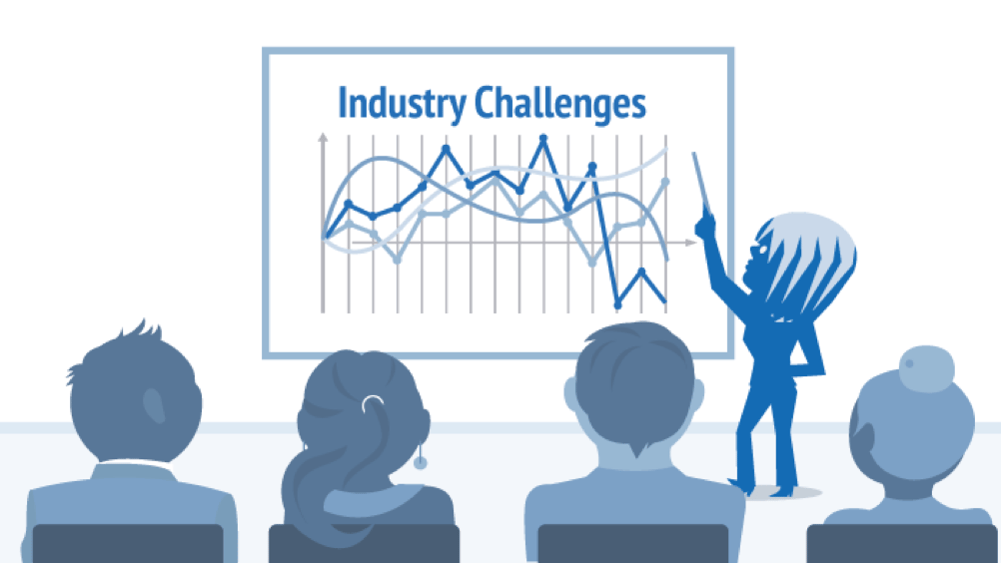The changes in IT technology and its delivery formats have offered a platform for new players such as RamBase. Where, fifteen years ago, we expected consolidation in the ERP industry, precisely the opposite has happened. Was life easier in the good old days? No, we know for a fact that that isn’t true. Not convinced?
 Read Hans Rosling’s book Factfulness: Ten Reasons We’re Wrong About the World – And Why Things Are Better Than You Think, and let’s talk again.
Read Hans Rosling’s book Factfulness: Ten Reasons We’re Wrong About the World – And Why Things Are Better Than You Think, and let’s talk again.
However, when it comes to the choice of a software product, maybe life was somehow more comfortable in the good old days. If only having one choice is the easy option, then yes.
Before the Internet came along, software was delivered in one form factor only: On-premise and paid for upfront. Your main challenge was to choose the software that best matched your requirements. In many areas, that was a straightforward task and benchmarking a couple of applications against each other would provide the answer.
ERP-software was different
The first wave of ERP systems available to the SMB-market in the mid-1980s replaced paper-based and manual procedures. That alone was a huge leap forward in productivity.
The second and third wave was more complicated.
ERP software developed in the early 1990s was supposed to support re-engineered and more productive business processes, and suddenly we introduced many more variables in the change-management equation. Now we were looking for software that could support processes that were not yet implemented. Processes that looked right in theory but hadn’t been exposed to the brutal reality of actual human behavior.
With customizable ERP systems, you could more freely start with designing the solution blueprint and then chose the software that best matched the planned scenario. The gaps could be filled with bespoke development. This waterfall approach to ERP software selection turned out to be much more complicated than expected. Starting the business process analysis and optimization effort on a blank page often resulted in a design specification that no software could meet and then the customization effort became surprisingly expensive.
The promise that became the curse

The first wave of digital transformation in the SMB-market started only thirty-five years ago. Twenty years later, all companies were equipped with workstations, servers, networks, operating systems, databases and applications. IT operations had become a critical and core competence that all SMBs had to master. Keeping hardware and software updated and flying became mission-critical. When the IT systems were down, the companies were down.
And the IT departments now became bottlenecks.
As the need for IT competence exploded, the competition for qualified IT people increased correspondingly, and the open positions became harder and harder to fill. New software applications became available to help all functions outside the ERP domain. Still, despite line managers’ cry for productivity improvements, most were blocked due to incompatibility with the incumbent IT platform and by an IT department already overloaded with work. The on-premise customizable delivery format that promised so much for the SMB market became a problem and a hindrance for business innovation.
Then came the Internet
When Netscape launched its Navigator browser in 1994, few understood the profound impact it would have on almost anything. What we today call digital transformation started in the wake of getting easy access to the Internet.
Most vivid was the transformation of the music industry where Napster made sharing of mp3 files easy and effortless. In a little under two years, Napster had attracted 80 million registered users. In 2000, heavy-metal rock band Metallica realized that their entire back catalog was available for free download and that a not-yet-released track from a new album was played on radio stations around the world. The established music industry panicked and for good reasons. Napster was found guilty of copyright infringements and had to close shop, but not everyone was happy. It turned out that Napster had become a promotion channel for up-and-coming musicians. The band Radiohead assigned their success with the album Kid Ato the pre-release of material on Napster. Napster had become a medium where musicians could get access to their audiences without having to deal with intermediaries and the establishment.
Application Service Provider
At the CeBIT fair (Hannover, Germany) in 2000, I was repeatedly questioned by journalists about my position on the new phenomenon of Application Service Provider (ASP). Then working for ERP company Damgaard, I had to embrace the concept and speak positively about it. However, in reality, we hated the idea and were technically light-years from being able to deliver it. ASP was a threat to our business model and that of our resellers.
It was companies like Salesforce.com, that in 1999 launched their CRM application with the pay-off “no software”, which challenged the on-premise nature of the software industry. Make no mistake; the established software industry did not embrace the ASP and the SaaS delivery formats. Serving these new delivery formats required a complete redesign and rewrite of the software. Making ASP and SaaS versions of on-premise software required huge investments at a point where no one knew if this was just another fad. As with most new technology, the push came from the user community and the insurgents, not from the established industry.
Why the cloud is such an attractive delivery model?
The answers are not complicated. There are three main reasons why the adoption rate of cloud ERP solutions is currently on the steep portion of the market penetration curve:
- Price
- Security
- Simplicity
Why does price matter?
Why don’t we all have a power generator in the garage? Because it’s far more cost-effective to produce power in large plants and make it available out of plugs in our walls when we need it. Data storage and processing are equivalent to electricity. We all need it, but we don’t all need to make it.

The price of computers and storage has decreased while the demand for capacity has increased. Check out the research comparing on-premise with cloud solutions and the findings are that the total cost of capacity in the cloud is much less expensive than the on-premise alternative. It’s economy of scale, and it is hard to beat.
There is no apparent reason why software delivered as a service (SaaS) should have a lower lifetime cost than the on-premise and perpetual alternative, but reality shows that it does. Software prices have declined over the years, and the trend has continued after the SaaS/cloud delivery format was introduced.
The shift from upfront pre-paid perpetual licenses to periodical subscriptions have changed the cash flow profile of IT consumption from CAPEX to OPEX. That is an advantage to most companies, and it has supported making decisions for using IT solutions in larger organizations independent from the IT department. To most that represent a welcome goodbye to a much-despised bottleneck.
Learn more about what costs SMBs need to consider when evaluating different ERP systems
Why does security matter?
Is your data safer on the server in your garage or in the cloud? Where do you keep your money? In the garage or in the bank?
We are all concerned with theft, data leakage and deletion. In this respect, the need for security in the cloud is no different from the needs of our in-house data center. In the cloud, the costs of maintaining facilities and hardware are included in the price, and you are offered tools to monitor and protect the data traffic into and out of your cloud resources.
All cloud providers are sincerely concerned about security and offer more of it than any SMB company can ever afford to apply on an individual basis. Many cloud providers are even certified by independent third-party auditors to attest that their internal security processes are in place and that they are effective in managing and protecting your data.
Check out what security measures are important for good cloud security
Why does simplicity matter?
With your own data center, you are responsible for systems administration, capacity, availability and uptime. With a cloud-based solution, you’re not. While IT systems are vital to the operation of any company, maintaining an IT infrastructure is not. Of course, there is no guarantee that a cloud-based system cannot fail. However, if you compare the statistics, then the individual on-premise alternative never wins. The cloud providers have reliable backup and escalation procedures in place that kick in when glitches and outages occur.
While there is no law of nature declaring that cloud-based software should be more user-friendly than their on-premise ancestors, it just seems that it always is. Maybe it’s because we started with the simpler systems being offered as a service and perhaps it is because most SaaS providers, such as RamBase, see the good effect of delegating training and support to their partners and focusing themselves on developing the product?
Simple solutions are also much simpler to test. All you need is a browser or a client app. The hardware, the application and the underlying stack of software are not your concern.
"Best-of-breed, systems integration and citizen developers" are the new black
“Software is eating the world” (now we call it digital transformation) means that IT creeps into all corners of the enterprise. Today there is not a function or an activity in a company where IT does not play a crucial role. The philosophy of the previous century – where a monolithic system with one central database should provide the IT backbone for the company – proved unrealistic. Such systems became huge monsters that were difficult to build and expensive to maintain. They also became barriers against innovation, which requires that you can rapidly change the underlying IT systems.
Today, a modern IT solution in the SMB-market consists of a core ERP kernel, such as RamBase, that closely matches the characteristics of the business and a series of satellite applications for other activities such as marketing, sales, HR, project collaboration, reporting, internal and external communication, product planning and management etc. Wherever needed, these applications exchange data through APIs, and they are all cloud-based. Special requirements will primarily be filled by citizen developers using tools such as Microsoft PowerApps.

Citizen development is a low-code approach to software development that allows people to create programs without needing to know anything about programming languages or how to write code. The objective of citizen development is to reduce the time and effort associated with making new IT tools that support critical business initiatives, processes and activities.
Learn more about the platform possibilities with RamBase
The impact on the ERP-industry
The installed base of ERP systems in the SMB-market today is still predominately on-premise or hosted. Will customers really want to move to the cloud?
The simple answer is: YES.
When it comes to implementation time, ease of roll-out, mobility, scalability, availability, performance, security, integration, reporting and operations, nothing can beat the cloud. If you have an internal IT department they may argue otherwise, but they are biased and fight for their jobs. I have researched the Internet for studies comparing on-premise with cloud and haven’t found anything that recommends that you keep investing in your in-house data centers. When it comes to infrastructure, the cloud provides the lowest total cost of ownership. Period.
However, when it comes to ERP, the deciding issue is the software. Is there a suite of applications in the cloud that match your requirements?
There are thousands of specialized software houses, among those many that have extended or customized other vendors’ applications, and they are now faced with a genuine challenge. Moving their ERP software to the cloud requires that they first rewrite the code, deploy it for cloud delivery, switch to a subscription-based charging format and then reorganize their consulting departments. To keep their current customers happy and continue charging the annual twenty percent upgrade and maintenance fees, they cannot release resources from their on-premise products and business model.
For the majority of ERP suppliers, this represents a nightmare scenario. They know that their current customers will eventually move to the cloud. They don’t know when, but they do know that the customers will certainly consider alternatives and some of them will go elsewhere.

The situation has implications for the customers, too. When the time for a change is right, they will research their options and if a cloud-based alternative is available then that will be the choice. If a cloud-based solution is not available, then they may be forced to continue with a customized one. As more and more cloud-based solutions become available, fewer and fewer customers will be forced to take the customized course.
The big question is who will move fastest into the new playground? Will the current incumbents with their on-premise-based software take the lead or will new insurgents with no legacy deadweight come first?
So far, the incumbents with their installed base of on-premise licenses and their partner eco-systems, living from the services required to keep them updated, have been slow to react. Everywhere you look, the market has been conquered by insurgents free of legacy commitments. It has started in the SOHO (Small Office – Home Office) end of the market and is now moving upwards.
The changes in IT technology and its delivery formats have offered a platform for new players such as RamBase. Where fifteen years ago we expected consolidation in the ERP industry, precisely the opposite has happened. Customers are exposed to more choices through the improved transparency offered by the Internet.
The rush to the cloud is accelerating and we are already way past the tipping point. With the ability to mix and match applications, I expect niche players such as RamBase Cloud ERP will enjoy fast and steep diffusion curves.
Hans Peter Bech M.Sc. (econ.)
tbkconsult.com







